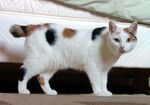Difference between revisions of "Megacolon"
| Line 3: | Line 3: | ||
Megacolon is a state of permanently increased diameter of the large bowel. This change in intestinal structure leads to abnormal function, including reduced colonic motility and chronic constipation. The condition most commonly occurs in cats and dogs, but pigs can also be afffected. White foals suffering congenital colonic agangliosis, an autosomal recessive trait, may develop secondary megacolon. | Megacolon is a state of permanently increased diameter of the large bowel. This change in intestinal structure leads to abnormal function, including reduced colonic motility and chronic constipation. The condition most commonly occurs in cats and dogs, but pigs can also be afffected. White foals suffering congenital colonic agangliosis, an autosomal recessive trait, may develop secondary megacolon. | ||
| − | In small animals, megacolon may be congenital or acquired, which may be idiopathic. Although well described | + | In small animals, megacolon may be congenital or acquired, which may be idiopathic. Although well described in human medicine, congenital megacolon has not been convincingly described in animals despite first being reported in 1988<sup>1</sup>. In man, Hirschsprung's disease manifests at a very young age is caused by an absence of inhibitory neurons in Meissner’s submucosal plexus |
| + | and Auerbach’s myenteric plexus in the distal colon or rectum<sup>2</sup>. This gives persistent smooth muscle contraction in the affected region and proximal dilation of the colon. A similar pathogenesis is proposed in cats. | ||
| + | |||
| + | Acquired megacolon is more common than the congenital form, and in cats this is most often idiopathic. The true cause of "idiopathic" megacolon is thought to be an intrinsic defect in colonic smooth muscle function<sup>3</sup>. Aquired megacolon can occur in both cats and dogs as a sequel to any disease or lesion that interferes with normal defecation: faecal retention caused dilatation of the colon and impairs colonic motility. Causes could include neuromuscular abnormalities (spinal cord disease, intervertebral disk disease, dysautonomia, trauma), metabolic disorders (severe dehydration, hypokalaemia), drug therapy (vincristine, anticholinergics, barium), mechanical obstruction (pelvic fracture malunion, foreign bodies, stricture, anal/rectal atresia) and conditions causeing dyschezia (anal sacculitus, perianal fistula, trauma preventing posturing, procititis). After megacolon has persisted for several months, it is unlikely that normal colonic motility will be restored after resolution of the underlying cause. In many cases, the aetiology of megacolon is not determined. | ||
==Signalment== | ==Signalment== | ||
Revision as of 10:59, 11 August 2010
Description
Megacolon is a state of permanently increased diameter of the large bowel. This change in intestinal structure leads to abnormal function, including reduced colonic motility and chronic constipation. The condition most commonly occurs in cats and dogs, but pigs can also be afffected. White foals suffering congenital colonic agangliosis, an autosomal recessive trait, may develop secondary megacolon.
In small animals, megacolon may be congenital or acquired, which may be idiopathic. Although well described in human medicine, congenital megacolon has not been convincingly described in animals despite first being reported in 19881. In man, Hirschsprung's disease manifests at a very young age is caused by an absence of inhibitory neurons in Meissner’s submucosal plexus and Auerbach’s myenteric plexus in the distal colon or rectum2. This gives persistent smooth muscle contraction in the affected region and proximal dilation of the colon. A similar pathogenesis is proposed in cats.
Acquired megacolon is more common than the congenital form, and in cats this is most often idiopathic. The true cause of "idiopathic" megacolon is thought to be an intrinsic defect in colonic smooth muscle function3. Aquired megacolon can occur in both cats and dogs as a sequel to any disease or lesion that interferes with normal defecation: faecal retention caused dilatation of the colon and impairs colonic motility. Causes could include neuromuscular abnormalities (spinal cord disease, intervertebral disk disease, dysautonomia, trauma), metabolic disorders (severe dehydration, hypokalaemia), drug therapy (vincristine, anticholinergics, barium), mechanical obstruction (pelvic fracture malunion, foreign bodies, stricture, anal/rectal atresia) and conditions causeing dyschezia (anal sacculitus, perianal fistula, trauma preventing posturing, procititis). After megacolon has persisted for several months, it is unlikely that normal colonic motility will be restored after resolution of the underlying cause. In many cases, the aetiology of megacolon is not determined.
Signalment
Congenital megacolon is not well studied in cats and dogs but does appear to occure in both species. Any age, breed or sex of animal may develop aquired megacolon, but idiopathic megacolon is more common in middle-aged to older cats. There is also some evidence for an increased risk of megacolon in Manx cats.
Diagnosis
Clinical Signs
Laboratory Tests
Diagnostic Imaging
Pathology
Treatment
Prognosis
Links
References
- Rosin, E et al (1988) Subtotal colectomy for treatment of chronic constipation associated with idiopathic megacolon in cats: 38 cases (1979-1895). Journal of the American Veterinary Medical Association 193, 850-853.
- Washabau, R J and Stalis, I H (1996) Effects of cisapride on feline colonic smooth muscle function. American Journal of Veterinary Research 57, 541-546.
